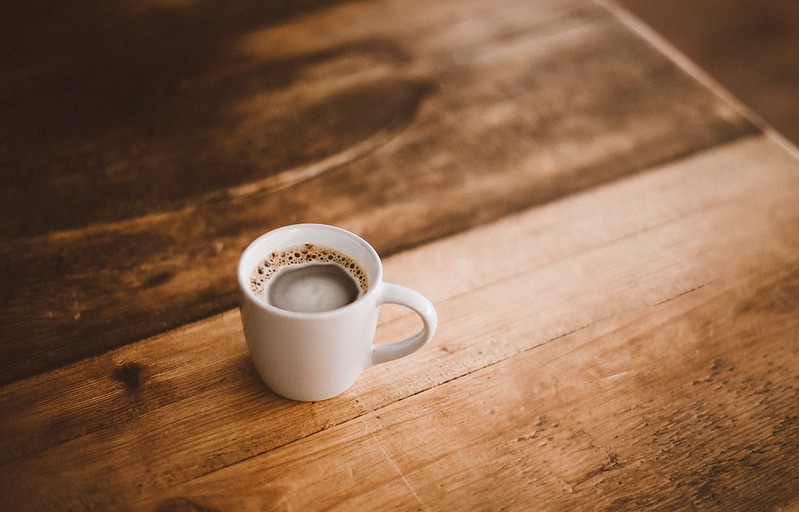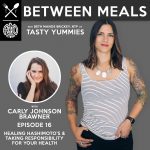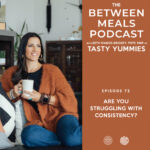This 14-Day Caffeine-Free Challenge serves as an opportunity to break the caffeine addiction for good or as a temporary break to give your neurotransmitters a hard reboot. Consider it a reset to your caffeine tolerance.
The 14-Day Caffeine-Free Challenge // Reset Your Caffeine Tolerance
To simplify it, as your body becomes accustomed to consuming caffeine, you need to consume more and more of it to experience the same energy boost. Acting in a similar manner to anti-depressants, high doses of caffeine on a regular basis acts as central nervous system stimulant and can flood the brain with neurotransmitters, creating neurotransmitter resistance or long term receptor damage 18. Olekalns, N. (1996). Rational addiction to caffeine. Journal of Political Economy, 104(5), 1100.
Reasons to Take a Break From Caffeine and Reset Your Caffeine Tolerance:
- Caffeine no longer affects you the way that it once did
- You crave caffeine and NEED it to start your day or to get through the day
- Your daily caffeine consumption amounts are insane
- You are experiencing high levels of stress, anxiety, anxiousness or adrenal fatigue
- Your sleep health has been suffering
- It’s leading to health problems
- Doctors orders
How-to Beat the Coffee Addiction
The good news: to kick the caffeine habit, you really only need to get through about 7-12 days without drinking any caffeine. During that time, your brain will naturally decrease the number of adenosine receptors on each cell, responding to the sudden lack of caffeine ingestion. If you can make it that long without a cup of joe or a spot of tea, the levels of adenosine receptors in your brain reset to their baseline levels, and your dependence will be broken. 2https://www.smithsonianmag.com/science-nature/this-is-how-your-brain-becomes-addicted-to-caffeine-26861037/
You can certainly go cold turkey on cutting out caffeine for this 14-day challenge, but if you are a hardcore caffeine consumer, you may want to consider preparing by cutting back gradually and replacing your traditional caffeinated coffee with either half decaf or more gentler forms of caffeine, found in quality teas like green or black tea. I personally really LOVE a Matcha White Hot Chocolate as a gentler alternative to caffeinated coffee, such a treat.
How-to Take a Break from Caffeine and Reset Your Caffeine Tolerance:
Option 1: Cut Back Gradually
In the week before you plan to go caffeine-free take these steps to slowly taper off, this will be especially helpful if you consume several cups of caffeinated coffee (or other sources of caffeine daily). For example, if you are consuming 800 – 1000 mg of caffeine each day (which would be around four 12oz cups of coffee), start by reducing it by 250 mg each day or every other day in the week leading up – giving your body time to acclimate to the change. If you are consuming less caffeine per day, consider reducing by 20-50mg per day until you are at or near zero daily caffeine.
To keep it simple without needing to calculate mg of caffeine, you can plan to reduce your coffee consumption down 1/4 cup every 2 to 3 days and reduce your caffeinated tea down 1/2 cup every 2 to 3 days leading up.
Benefits to Cutting Back Gradually:
- little to no caffeine headaches
- it is less shocking to your system
- withdrawal symptoms are likely to be less severe / avoided.
I wasn’t super planned out in my tapering down, but in the time leading up to my break from caffeine, I found that switching over to half decaf coffee some mornings, full decaf on others, and green tea on others still – this helped to help keep my body “on it’s toes” and guessing – which made the full and complete detox from caffeine so much easier.
Begin to also increase your water consumption, in this time, you should always be looking to get around 1/2 your body weight in ounces every day as a minimum, (more if you consume diuretics like coffee, tea, soda, juice, etc) with a maximum intake of around 100oz or so. Slowly sip quality filtered water throughout the day, don’t guzzle. Increasing your water gradually in this week’s time, leading up, will help to flush/detox your body from the caffeine.
Option 2: Go Cold Turkey
Going cold turkey is certainly an option especially if you don’t consume a large amount of caffeine each day. When you cut cold turkey and simply wake up one day and decide to cease all consumption of caffeine, this is certainly a very effective and probably the fastest way to detox from caffeine. I love that in doing so, you can truly see the effects of caffeine on the body’s functioning. But, depending on how much you consume, going cold turkey can come with some severe caffeine withdrawal symptoms, including headaches, loss of productivity, irritability, lethargy, muscle pain and stiffness and for some people it just creates more of a tendency to give up. So if you go this route, just know that it’s certainly more challenging.
Make it Easy On Yourself:
- Find a good replacement drink BEFORE you start the reset and start swapping it in, randomly for your current caffeine beverage of choice (see suggestions below).
- I suggest starting a reset like this on the weekend, so you can give yourself the space to relax and not have your productivity affected.
- If your headaches and other withdrawal symptoms are bad, try Epsom salt baths, CBD oil or other natural pain relief methods until they subside.
- During the reset, seek your energy boosts in other non-caffeinated ways, prioritize high-quality, nutrient-dense foods that will fuel you for longer (prioritizing high quality proteins, fats and of course, lots of fiber-rich, non-starchy vegetables), get lots of exercise, meditate and drink plenty of water.
- Enlist a friend or loved one to join you in the reset, or even better join us in The Tasty Yummies Taste Buds, our private Facebook Group, where we are starting a group challenge on June 1st (I will be posting more about in in this coming week)
What to Expect on your Caffeine-Free Challenge and as your Reset Your Caffeine Tolerance:
How your body responds is highly dependent on how much caffeine you had been drinking, your personal biochemistry, how “addicted / dependent” you are on the caffeine, lifestyle, and many other factors. (you can read more here) At the start of the reset you may notice brain fog and lack of alertness. Your muscles may feel fatigued, even without any strenuous activity and you may feel a bit more irritable than usual. On the first day or two you may also experience a throbbing headache or two and your ability to concentrate may be challenged. Muscle pains, nausea and other flu-like symptoms. This is why I suggest beginning a caffeine reset at the start of the weekend so you can manage any issues and control your relaxation, your self care and management of withdrawal. Before long you will notice your energy levels skyrocketing, the brain fog will lift and you will likely be more focused.
For me, I tapered down and cut back gradually on the caffeine before my official caffeine reset began and I had a fairy decent headache the first day, a minor, dull headache on the second day and that was really it. My cravings for coffee have certainly subsided, as well. The first week, I was still consuming decaf coffee every day, to keep my morning rituals. After that first week, I realized that there were some mornings I wasn’t consuming decaf or any other beverage besides my morning water. It just happened naturally.
The 14-Day Caffeine-free Challenge:
14 days of no caffeine – this means no caffeinated coffee, tea, soda, energy drinks and yes, I would highly recommend that this reset period also include chocolate! (some dark chocolates can contain as much as 150-200 mg of caffeine per 100g, for reference a cup of 8oz coffee has between 95 – 165mg)
Days 1-14: Start your day with at least one 12 ounce glass of water (not ice cold, just room temperature or warm), you can add lemon, if you’d like. Slowly sip, before you drink any other beverages.
If your morning coffee is a ritual, you can switch to full decaf* coffee (I always recommend a very high quality Swiss Water Process Whole Organic Bean) or if you want to move fully away from the taste of coffee, or want to ensure that you are 100% guaranteed not to have any small traces of caffeine, consider a nice hot or iced herbal tea, I’ve been loving hibiscus tea.
You may notice some headaches and cravings on days 1-4, be sure you are consuming enough water and know that this is temporary and it will pass.
If you are experiencing sugar cravings in this time, don’t give in and replace your caffeine consumption with sugar or highly refined carbohydrate foods as a means for quick energy bursts – it doesn’t end well.
(Note: it takes approximately 7-12 days to reset your neurotransmitters and how they respond to caffeine, so if you only want to go 7 or 10 days without caffeine, I will leave this up to you. I personally like the idea of a full 14 days, as everyone’s tolerance and response will vary due to how much caffeine they’ve been consuming and for how long, plus I like the idea of an even two weeks.)
After Day 14: After the 14-day Caffeine-Free Challenge, it will be up to you, based on how you feel if you want to go right back to caffeine and simply use this 14 day detox as a reset, or if you continue to remain caffeine free. That’s up to you and how you feel. Pay attention to the subtle cues your body is communicating to you, do you notice heart palpitations, anxiousness, amplified stress levels, as you reintroduce caffeine? It may not be right for you.
If you plan to go back to caffeine, go slow and go with less than you were drinking before the reset and know that this time gave your neurotransmitters a hard reboot, so your tolerance to caffeine will likely have been lowered and changed drastically vs before the reset.
You may choose to move over to a more gentle form of caffeine like matcha or other quality, antioxidant and polyphenol-rich organic caffeinated teas.
As always, it’s important to listen to YOUR body and know that taking a break in this manner can (and possibly should) be something you come back to monthly, every other month or whenever you feel you need it. You can also shorten your Caffeine-Free Challenge to just 7 days – it is whatever you want and need it to be.
Join The TY Taste Buds, our Closed Facebook group to join others in this 14-Day Challenge no matter when you start. AND for direct support, please join the Caffeine Free Challenge email list, you will receive emails for this easy challenge, with support, research, recipe ideas and more.
*Please note: Some decaffeinated coffees can contain low levels of caffeine, 5-10mg has been found in an 8 ounce cup of some brands of decaf coffee compared to approx 85mg in an 8 ounce cup of caffeinated coffee. Coffee that is decaffeinated using the Swiss Water Process method can remove up to 99.9% of caffeine.
For this reason, I would suggest only ONE cup of decaf coffee a day, maximum, during this 14 day reset period and if it is imperative that you are 100% caffeine free, for medical purposes or otherwise, I would suggest avoiding it altogether.
Alternatives to Caffeinated Coffee for the Purpose of a Caffeine Reset:
- Swiss Water Process Decaffeinated Organic Coffee (I have been enjoying Allegro’s Decaf Organic Whole Beans)
- Herbal Teas
- Decaffeinated Teas
- Warm Lemon Water
- Infused Spa Water
- Herbal Element Herbal Coffee
- Teecino Chicory Herbal Coffee (if you are gluten-free, be sure you select their GF blends, some contain barley )
- Dandy Blend Herbal Coffee
- Golden Milk Latte
- Healing Golden Bone Broth Latte
- Beet Latte
- Iced Coconut Vanilla Bean Hibiscus Tea Latte
Coffe photos by Nathan Dumlao on Unsplash
References
| 1. | ↑ | 8. Olekalns, N. (1996). Rational addiction to caffeine. Journal of Political Economy, 104(5), 1100. |
| 2. | ↑ | https://www.smithsonianmag.com/science-nature/this-is-how-your-brain-becomes-addicted-to-caffeine-26861037/ |















